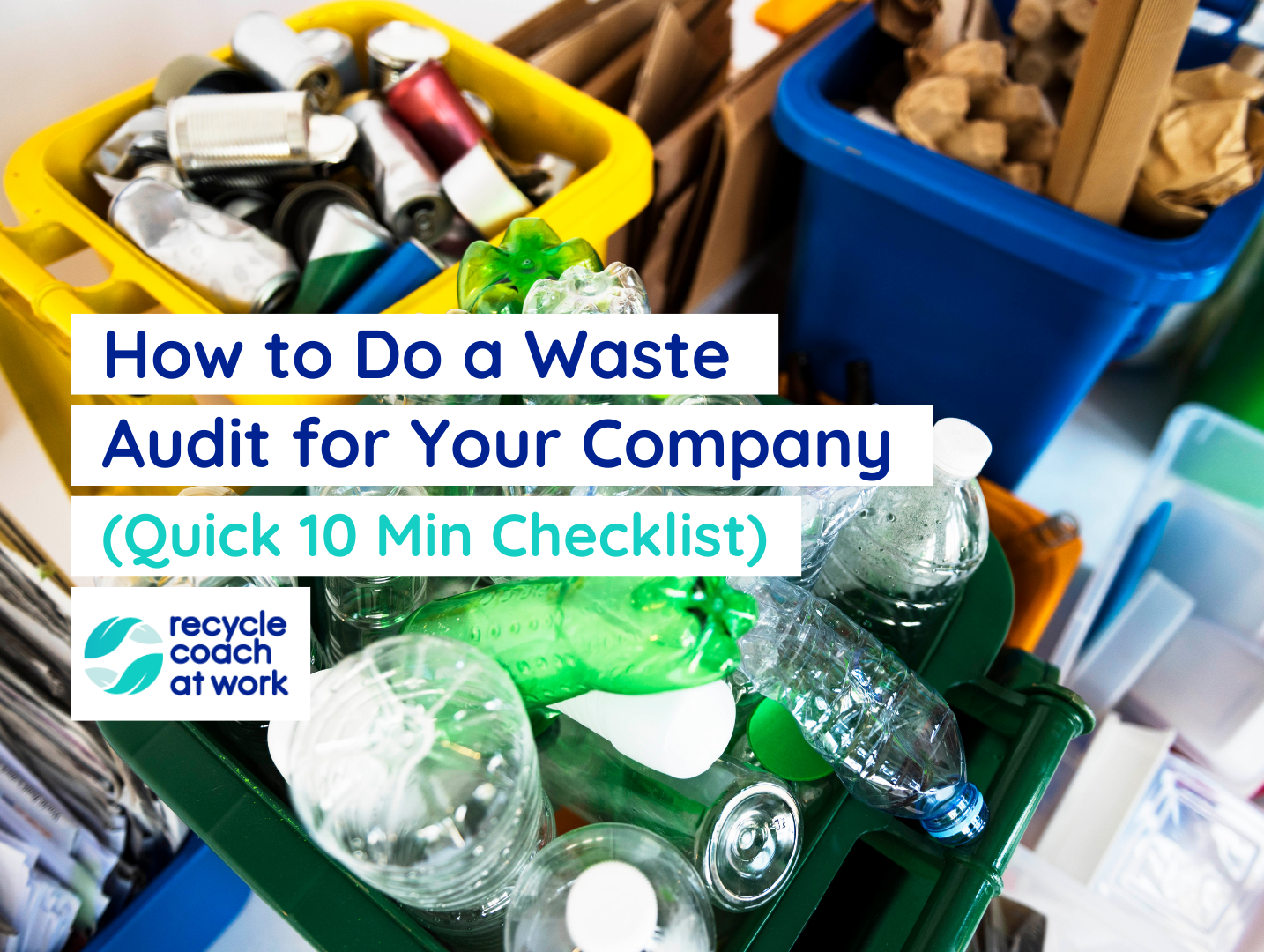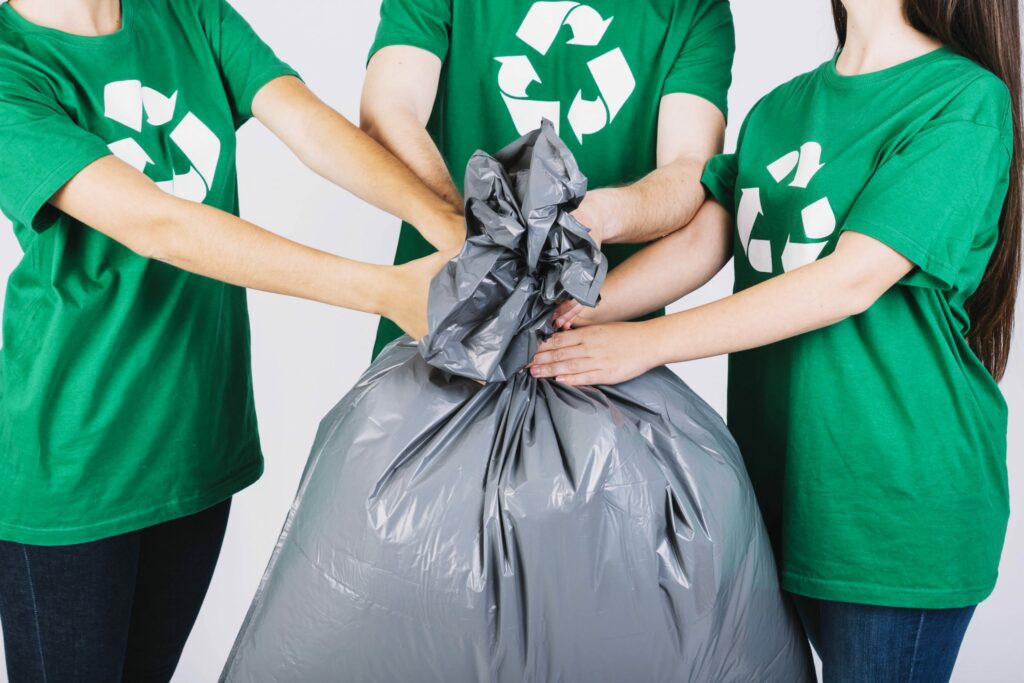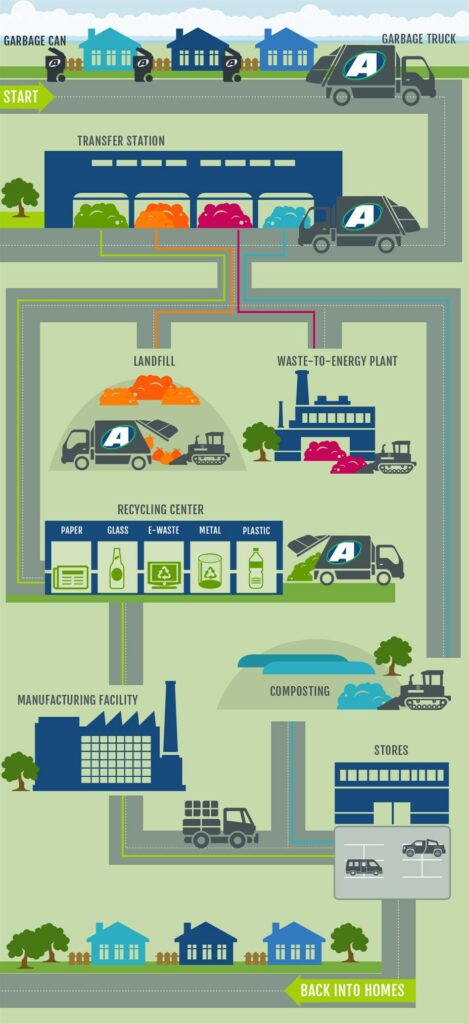How to Do a Waste Audit for Your Company (Quick 10 Min Checklist)

Do you know how to do a waste audit for your company?
According to Great Forest, 77% of corporate trash is made up of paper, glass, metal, e-waste and organic materials that can – and should – be recycled. Only 23% of trash is worthy of the landfill.
If you’ve been given the go ahead to audit how much waste your company disposes of, it’s up to you to find out what type of waste it is, if you can reduce your landfill disposal rate, and save money.
You need a quick and easy checklist that will help you outline your next steps – so that your team can get moving on what matters – making your company more waste efficient.
First, a bit of orientation on what you’re dealing with.
What is a Waste Audit, Really?
To understand how to do a waste audit, you first need to know what it is.
A good audit of your company’s waste will tell you everything you need to know to streamline your trash disposal and recycling practices, for the benefit of your waste management processes.

Your basic waste management plan is usually made up of an audit, a waste diversion and a waste reduction strategy. There are also different types of waste audit, according to what your goals are as a company green team.
What Are Your Companies Waste Audit Goals?
Waste audits happen for a number of reasons:
- To benchmark your company’s current processes & environmental impact
- To understand where the opportunities are for improvement
- Trend monitoring and development of new initiatives
- To reduce, reuse and recycle more waste, for less landfill disposal
What is recyclable trash, and what isn’t, are two common issues that must be solved. If you don’t have access to a web-based app, use a recyclepedia during your audit to look up what can be recycled, and what can be thrown in the trash.
You can also find out the collection requirements of your local municipality using our ‘Find My Municipality’ tool.
On the whole, conducting a waste audit is a great way to kick off a high performance recycling program. Let’s move onto auditing your office trash!
1: Plan Your Waste Audit
Planning is a vital step in the process for your green team. You need to figure out the who, the how and the why to get this done right. That means calling an official meeting.

- Assign roles and conduct a walk-through
Knowing how to do a waste audit starts with the right core team. Assign the best green team members you have to this important task, and host a company walk-through.
- Note where waste disposal takes place (locations)
During the walk-through, you’ll visit each disposal location and take note of any obvious issues. These are the locations your team will be collecting waste samples from on your allotted dates.
- Understand how waste is currently managed
What is waste management anyway? At the end of your first meeting, outline the A-Z of what happens from the time trash is created, to your hauler collecting it, to it being sorted at a waste transfer station – to when it arrives at the landfill.

Image credit: Advanceddisposal.com
Spend some time chatting about how corporate e-waste and other materials are currently managed. Take note of any glaring opportunities.
2: Recruit Your Cleaning Staff
Your green team can conduct the waste audit on their own, or you can enlist the help of your company’s cleaning staff. They will be instrumental in helping you pull off a successful audit!

- Host a staff meeting and enlist help
At your second meeting, invite key members of the cleaning staff so that you can chat to them about how to conduct a waste audit with your team.
No-one knows the disposal practices of your company better than your cleaning staff. Tap into their knowledge to learn what you can about your company’s disposal process.
- Run through a basic collection process
Once you have briefed them, and they’re inspired to help – run through exactly what you expect from them so that no questions are left unanswered. They need a full step by step process here.
3: Sync Your Schedule & Timelines
At that same meeting, set a logical time and date for regular waste audits that involve all of your committed team members and cleaning staff.

- Perform a 5 day audit
During week 1, audit your waste for 3-5 days to get an average.
- Do random audits for 2 weeks
Then, for the next 2 weeks following your initial audit, perform random audits to make sure your averages are correct.
Pick 2-3 days over those 2 weeks (after your initial audit period) to check that there are no major changes in weight or material content. If there are, investigate why.
Tip! Ask your cleaning staff if they know what is recyclable and what’s not. If they don’t know, give them access to your Ask Milo tool to make it easier, or decide to sort the trash yourself.
4: Design and Prep Your Audit Worksheets
Create or download a waste audit worksheet for your team to use during the disposal audit. This worksheet will help you capture the data you need for decision-making.

- Types of waste (determining composition and identifying them)
There are types of waste audit, and types of waste. As you design your worksheet make sure you record the composition or material of each waste type.
- Where certain waste types come from (paper from the copying machine room for example)
Create an area on your worksheet that will let you record where your waste sample comes from. That way you can spot where certain types of material are most commonly found on premises.
- What you will need to complete the physical audit
So here’s how to conduct a waste audit quickly and safely – have the tools you need on hand! On your worksheet, create a checklist of the required trash audit tools.
- A designated sorting area
- Protective clothing/gear
- A scale
- Trash bags
- A tarp for sorting through the trash
- Labels
- Worksheets & pens
- Storage containers
- Camera or phones
- Latex or nitrile gloves
- First aid kit
- Cleaning materials
- Labeled bins
- Clear goggles
- Your team
- Waste samples
5: Collect & Sort Sample Waste
The audits will last for about 1-3 hours, depending on the amount of trash you’re sorting through. Get your protective gear on, and wait for your sample deliveries.

- Collect location samples
You should grab samples from every disposal location at your office. If you have a designated corporate e-waste area, it must be audited. Collect your samples, and sort them into material categories using your tarp, labeled bins and team.
- Take photos
Every location should be analyzed separately. At the end of each location sample, take photos of the sorted trash. Your waste paper recycling bin for example will need 3 photos for your report.
- Record waste quantities and weight
During sorting, each bin category must be weighed and that weight recorded. Knowing how to do a waste audit is only step 1 – you’ll need these data quantities for later analysis in step 2.
- Estimate averages
After you’ve sorted every sample and have done the clean-up – you’ll be back in a meeting room estimating your averages. Convert your data into percentages, totals, opportunities and make a note of what is recyclable and what’s not.
Whether you need to look up metal paint cans, Tupperware or textbooks, our recyclepedia will tell you if it can be recycled.
6: Check Estimates Against Existing Records
Once all of your data is collected and refined, you can check it against existing records. This is where you will discover areas for improvement.

- Cross referencing with purchase records
Step 3 of how to conduct a waste audit is taking your data and cross referencing it with purchase records. This will help you understand how trash is created, and how much of what is bought is being discarded.
- Take note of external factors
Your waste management recycle bins will also contain trash from other sources. Take note of anything interesting (like a lot of batteries in location 4).
- Cross referencing with waste disposal company
Finally, cross reference your data with your waste disposal company’s data to reveal hidden gems. When you recycle shredded paper, waste management companies record your output. Get this data to use when you create your plan to reduce office waste.
7: Prepare Your Waste Audit Report
Your completed waste audit worksheet stack will be used to create a report for management. If you can prove what needs to happen using data, leadership will give you the go ahead!

- Graph and chart your findings
At your final meeting or two, spend time creating graphs and charts for your presentation. Compile all photos and highlight all opportunities found in your audit.
For example, if your plastic waste recycling is contaminated – mention that in your report, along with contamination rates and how it can be improved using a simple educational tool.
- Establish benchmarks
You have the data to benchmark your progress, well done! These benchmarks will act as your baseline starting point. There’s nowhere to go but up!
- Set goals for improvement
From here, you’ll want to establish new goals to improve every part of your waste management process. These goals you can represent as percentage improvements in your report.
Set ambitious goals for your company and order them by priority. For example, if one waste management (glass recycling) area is non-existent, work on that first.
Present these findings to your management team and to your company as a whole. Show stakeholders the opportunities in better waste management.
Asking the right questions like ‘what can I recycle for money?’ and ‘how much can we cut our landfill diversion by?’ are questions every employee at your company should entertain.
Here’s a quick recap of the checklist:
7 STEP CHECKLIST
1: Plan Your Waste Audit
- Assign roles and conduct a walk-through
- Note where waste disposal takes place (locations)
- Understand how waste is currently managed
2: Recruit Your Cleaning Staff
- Host a staff meeting and enlist help
- Run through a basic collection process
3: Sync Your Schedule & Timelines
- Perform a 5 day audit
- Do random audits for 2 weeks
4: Design and Prep Your Audit Worksheets
- Types of waste
- Where certain waste types come from
- What you will need to complete the physical audit
5: Collect & Sort Sample Waste
- Collect location samples
- Take photos
- Record waste quantities and weight
- Estimate averages
6: Check Estimates Against Existing Records
- Cross referencing with purchase records
- Take note of external factors
- Cross referencing with waste disposal company
7: Prepare Your Waste Audit Report
- Graph and chart your findings
- Establish benchmarks
- Set goals for improvement
And that’s how to do a waste audit using a quick and easy 10 minute checklist!
From planning your waste audit to compiling the report once the data is collected, now you have a route forward.
Which part of waste auditing do you find most challenging? Ask a question here.
1 Comment
Comments are closed.
Alice Carroll
September 27, 2021 at 8:12 pmThanks for the reminder that there also external factors to consider when it comes to corporate waste management. I’d like to know more about that because I plan to start my own company soon. I’d like to stay on top of the office’s cleanliness early on to make sure that the place stays tidy at all times.